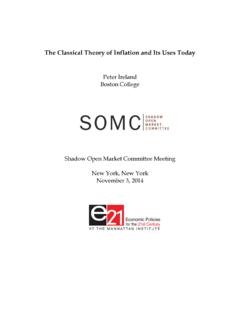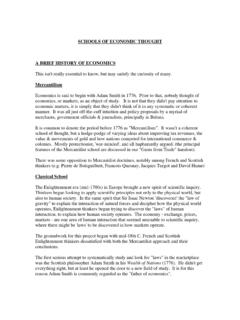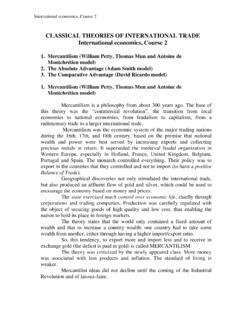Transcription of New Classical Economics - University of Connecticut
1 New Classical Economics Graduate Macroeconomics I. ECON 309 Cunningham New Classical Economics 1. Accepts model of GE with no imperfections. 2. Prices are perfectly flexible, and all markets are permanently cleared (S=D). All markets are self-correcting. 3. Individuals do not leave prices at false . levels since this would result in disadvantages. Equilibrium is optimal. 4. Because present actions entail future consequences, all agents deliberately form rational expectations. expectations That is, they exploit all available information at all times since it is in their best interests to do so. 2. New Classical Economics (2). 5. Agents adjust their decisions and actions so that their plans will be fulfilled optimally when their expectations are correct. 6. Therefore, expectations (and information). information play the dominant role in determining the state of the economy at any point in time. 7. They replace the deterministic setting with a stochastic one. People habitually suffer from expectational errors.
2 It is the errors that explain economic fluctuations. 8. Fluctuations and unemployment can be traced to voluntary deviations of supply and demand. 9. Thus the business cycle is an equilibrium phenomenon, phenomenon and is therefore optimal. 3. Two Types of Monetarism Kevin Hoover, JEL (March 1984). z Monetarism (Friedman). Marshallian: Small (partial equilibrium) models Aggregate Prices Money can fool agents on the short-run Mistakes can cause agents to act in ways apparently inconsistent with optimization Transient behavior occurs as agents learn (adaptive expectations). z New Classicals (Lucas, Sargent-Wallace, Barro). Walrasian: Large (general equilibrium) models Relative Prices Decisions made entirely on real factors Agents (to the limits of their information) act in ways consistent with successful optimization Continuously at equilibrium Agents make no systematic errors (REH). 4. The Twilight of the Monetarist Debate (1). Thomas Mayer, 1984 (Working Paper). z Monetarism Positivist Policy Orientation Pragmatic Based on Empirical Macroeconomics z New Classical /New Keynesian More Interested in Elegance than Forecasts Theoretical Rigor Based on Theoretical Microfoundations 5.
3 The Twilight of the Monetarist Debate (2). Thomas Mayer, 1984 (Working Paper). z What happened to Monetarism? Is it Dead? Shift in Methodological Preferences Absorption into Neo- and New Keynesian theories Weakness of the Monetarist Theoretical Case Errors in Presentation Failures: Velocity Change of 1980s Causality issues (endogeneity?). Research Agenda 6. Lucas Islands Model z Lucas, , Jr. Some International Evidence on Output-Inflation Tradeoffs, AER Vol. 63 No. 3. (1973). z Assumptions: Economy with single good traded. Suppliers are scattered across a large number of geographically separated markets (islands). Demand is unevenly distributed across the islands. Hence, prices vary across islands. No arbitrage across islands. Agents know the current price in their own market, but not current prices in other markets. Agents form expectations rationally. 7. Lucas Islands Model (2). P1 P2 P3 P4. P5 P6 P7 P8. Agents attempt to discern the general price level by observing the prices in markets.
4 They must attempt to discriminate between relative price changes and general price level changes (brought about by policy changes). This is the so-called signal extraction problem . 8. Lucas Islands Model (3). z Yields the Lucas Supply Function : y t = y t 1 + ( pt pt ) + ut s e z The depends upon the variance in prices across markets. z The greater the variance across markets, the more difficult the signal extraction problem, and the greater the error. z Greater error means greater short-run Phillips Curve tradeoff. 9. Sargent and Wallace (1976). z Rational Expectations and the Theory of economic Policy, Journal of Monetary Economics 2 (1976), 169-183. z There is no longer any serious debate about whether monetary policy should be conducted according to rules or discretion. Quite appropriately, it is widely agreed that monetary policy should obey a rule.. 10. Sargent and Wallace (2). (1) s yt = y t 1 + ( pt pt ) + ut , e E [ut ] = 0, var ut = u 2. (2) y td = (mt pt ) + v t , E [v t ] = 0, var v t = v2.
5 (3) y t = y ts = y td (4) mt = m * + y t 1. Pick (5) pte = 0 Static Expectations One: (6) pte = Et 1[pt ] Rational Expectations 11. Sargent and Wallace (3). Solution with Static Expectations u + v + t t yt = y t 1 + m*+. 1+ 1+ 1 + .. Solution with Rational Expectations u + v t t y t = y t 1 +. 1+ .. 12. Policy Ineffectiveness Proposition z How expectations are treated in macro models fundamentally affects the results!!!! z Under rational expectations (endogenous expectations), real output and employment are uneffected by systematic or predictable changes in aggregate demand policy. z If policy changes are systematic, therefore predictable, then agents will not make systematic mistakes in their forecasts. z Unanticipated policy changes will have a short-run impact. 13. Phillips Curve under REH. inflation LRPC. 2 5. 4 SRPC( 2). 1 3. 2 SRPC( 1). 1 Unemployment U1 U*. SRPC( 0). 14. More on PIP. z If a shock to the economy could be anticipated, and if it were to persist, then unanticipated aggregate demand policy could be used to offset its effects.
6 But if the shock could be anticipated by policymakers, then it could also be anticipated by all agents, and the policy response would also be anticipated and would therefore be ineffective. Shocks don't persist (aren't guaranteed to persist). z Hence there is no role for stabilization policy. z Systematic money supply policy would avoid expectational errors that would likely move the economy temporarily away from full employment. Therefore, adopt a constant growth rate rule for the money supply. 15. Lucas Critique (1). (REH ) y t = m * + ( )y t 1 + mt + t .. (SE ) y t = y t 1 + mt + t 1 + 1 + .. Both are estimated: y t = 0 + 1y t 1 + 2mt Under static expectations, expectations the coefficients are functions of the private agents behavioral parameters, not policy parameters. Under REH, REH the coefficients are policy dependent!!! 16. Lucas Critique (2). z Argues that econometric models cannot be used to predict the effects of proposed policy. z Because of expectations, relationships between economic variables (equations) change with policy changes.
7 Z Can we predict the economy at all? 17. Fiscal Policy z Deficit spending? People would anticipate the long-run costs of debt, and would act so as to offset deficit spending. They would increase saving to prepare for future tax increases. Fiscal policy would have little effect. This is the Ricardian Equivalence Theorem, and was restated by Robert Barro in the 1970s. 18. Monetary Misperceptions Theory of Business Cycles (1). Reason for Business Cycles: People make mistakes regarding monetary policy. Argument against: Agents have easy access to preliminary estimates of the money supply that are accurate and unbiases estimates of the actual money supply. Barro (1977). Anticipated Money Growth and Unemployment in the t United States, American economic Review, pp. 101-115. Barro fits a regression like: m n M = 0 + i +1 Gt i + j +1 Yt j +L+ t s i =0 j =0. and calls the residual the unanticipated money supply . 19. Monetary Misperceptions Theory of Business Cycles (2). Problems: 1.
8 Poor fit. Implies residuals may include some anticipated money. 2. This was particularly apparent when both quarterly and annual models were used. 3. Uses future information to construct anticipations.. 20. Monetary Misperceptions Theory of Business Cycles (3). The Test: fit the following regression to an unemployment rate series. Only this term was U = 0 + 1M As + 2 MUs significant! Results: 1. Only the unanticipated money supply was significant! 2. This is consistent with New Classical Theory (Lucas, Sargent & Wallace) and REH. 3. If people are aware of the actions of monetary policymakers, then the policies will be ineffective, not able to change unemployment. 21. Time Inconsistency z Kydland and Prescott (1977). Rules Rather than Discretion: the Inconsistency of Optimal Plans, JPE. z Because of endogenously formed expectations, optimal policies will not be optimal in practice. z A result of the linear optimal control structure? 22. New Classical View of Keynesian Economics z Failure on a grand scale.
9 Z Made up of ad hoc assumptions, not built on a strong foundation of rational agents. z Must assume rational, optimizing agents. z Must assume that markets clear. z Keynesians do not explicitly handle expectations, and expectations have been shown to be critically important. z Have not given explicit structural explanations of wage stickiness. z How can you explain persistence in business cycles? 23.







